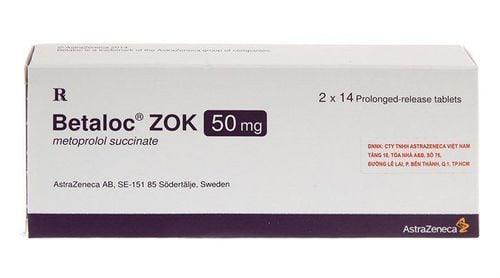This is an automatically translated article.
Madodipine belongs to the group of calcium channel blockers, with the main ingredient being Amlodipine. The drug is used to treat cardiovascular diseases. Detailed information about the drug Madodipine is detailed in the article below.1. What is Madodipine?
Madodipine contains the main ingredient Amlodipine with a strength of 5mg or 10mg. The drug is prepared in the form of tablets, packed in a box of 3 blisters x 10 tablets.
Mechanism of the drug:
Amlodipine blocks the slow calcium channels of the cell membranes, inhibits the influx of calcium through the membrane into the cell. The drug acts mainly on smooth muscle, reduces muscle tone of peripheral arterioles, reduces peripheral resistance, and lowers blood pressure. Coronary vasodilation also increases oxygen supply to the heart. Amlodipine also reduces renal vascular resistance, increases renal blood flow, and improves renal function.
2. What are the effects of Madodipine?
Madodipine is used to treat:
Essential hypertension. Stable angina, vasomotor angina (Prinzmetal), myocardial ischemia.
3. Dosage and how to use Madodipine
Dosage:
Initial dose: Take 5mg / time, 1 time / day. Maximum dose: 10mg depending on the patient's response. Patients with hepatic impairment require lower doses. When co-administered with thiazide diuretics or ACE inhibitors: No dose adjustment is required. How to use:
Read carefully the instructions for use of Madodipine before using. Madodipine is administered orally. Take the medicine with water. Madodipine should be taken at the same time of day.
4. Contraindications of Madodipine
Do not use Madodipine in people who are hypersensitive to Amlodipine or to any of its ingredients.
5. Madodipine side effects
Common side effects:
Fatigue, nausea, edema. Drowsiness, headache, dizziness, lightheadedness. Palpitations, abdominal pain, flushing, palpitations. Uncommon side effects:
Digestive disturbances, joint pain, muscle pain, shortness of breath. Gum hyperplasia, gynecomastia in men. Impotence, frequent urination, mood swings. Itching, rash, visual disturbances, erythema. Rare side effects:
Asthenia, cramps. Jaundice.
6. Notes when using Madodipine
During pregnancy: Using Madodipine during pregnancy can cause miscarriage, teratogenicity, fetal malformation, especially in the first trimester. Therefore, Madodipine should not be used by pregnant women. During lactation: Madodipine may pass into breast milk to the infant. Therefore, Madodipine should not be used or should be limited during lactation. Madodipine should be used with caution in patients with severe coronary artery occlusion, as it may increase the severity, duration, and frequency of angina or myocardial infarction. Madodipine should be used with caution in patients with congestive heart failure, as it may increase cardiovascular events and mortality. Madodipine should be used with caution in patients with hepatic impairment, since Amlodipine is metabolised in the liver. Madodipine should be used with caution in patients with acute porphyria or aortic stenosis. Caution should be exercised when increasing the dose of Madodipine in the elderly. Madodipine side effects may affect the ability to drive and use machines. Overdose, missed dose and management:
Overdose can cause excessive peripheral vasodilation and tachycardia, prolonged hypotension, shock, death. When overdosing Madodipine, it is necessary to monitor the electrocardiogram, treat symptoms, take activated charcoal, gastric lavage, and adjust electrolytes. If you miss a dose of Madodipine, take it as soon as you remember. If more than 12 hours have passed, skip the missed dose and take your next dose as usual. Do not double the prescribed dose of Madodipine. Drug Interactions Madodipine
Non-steroidal anti-inflammatory drugs may reduce the hypotensive effect of Madodipine by inhibiting prostaglandin synthesis, increasing sodium and fluid retention Sympathomimetics may reduce the antihypertensive effect of Madodipine. Madodipine. Anesthetics may potentiate the antihypertensive effect of Madodipine and may produce more potent hypotension. Concomitant use of lithium with Madodipine can cause neurotoxicity, nausea, diarrhea. Madodipine may alter blood levels of drugs that are highly protein bound, such as coumarin or hydantoin. CYP3A4 inhibitors may increase Amlodipine concentrations increasing the risk of hypotension. CYP3A4 inducers may alter blood levels of Amlodipine. Madodipine may increase blood levels of tacrolimus. Madodipine may increase blood levels of rapamycin (mTOR) inhibitors. Madodipine is a medicine used to treat cardiovascular diseases such as high blood pressure and angina. Because Madodipine is a prescription drug, patients should not use it on their own, but need to contact a specialist directly for a suitable prescription to ensure safety for health.













